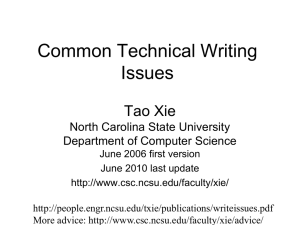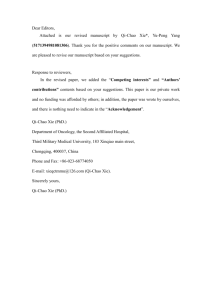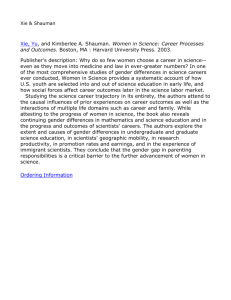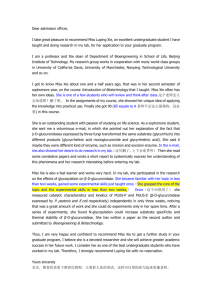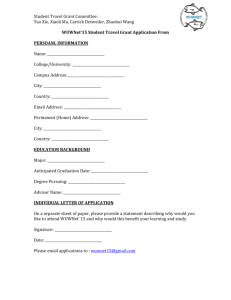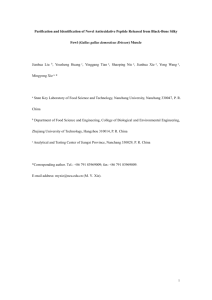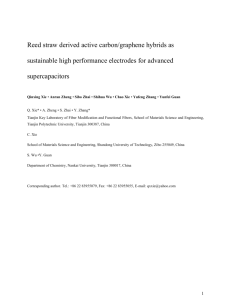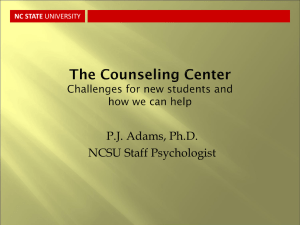Common Technical Writing Issues
advertisement
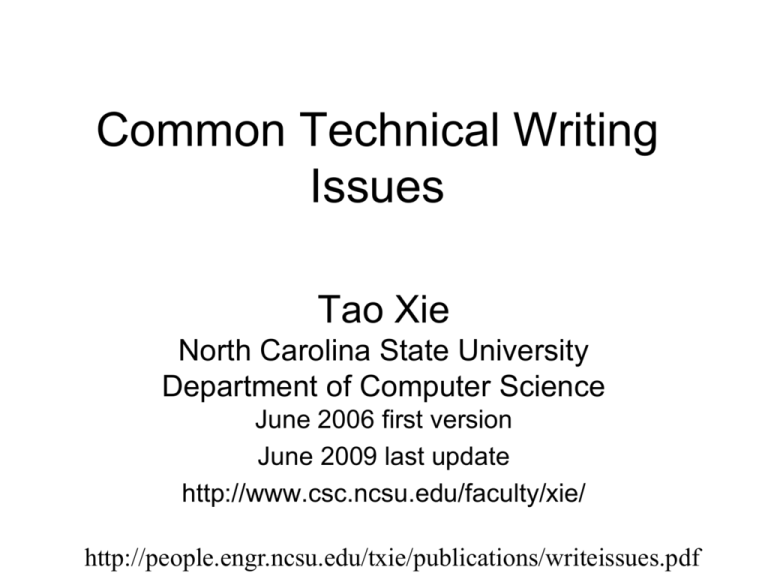
Common Technical Writing
Issues
Tao Xie
North Carolina State University
Department of Computer Science
June 2006 first version
June 2009 last update
http://www.csc.ncsu.edu/faculty/xie/
http://people.engr.ncsu.edu/txie/publications/writeissues.pdf
Important goal
• Don’t make readers a hard time in reading
your papers
– Your technical content is already hard enough
Avoid ambiguous words
• “since” “because”
– Bad: components may become coupled since
the adaptation introduces dependency.
•
•
•
•
•
“while” “although”, “whereas”
“method” “technique”, “approach”
“function” “functionality”
“if” “whether”
“test” a question/hypothesis “answer” or
“validate”
• others?
Avoid strong words
• “always” “often”
– Bad: Coupling is always regarded as a fatal
factor for reducing maintainability
Avoid informal or offensive words
•
•
•
•
•
•
•
•
Avoid “obviously”, “clearly”, “apparently”
Avoid “very”?
“Though” “Although”
“above” “preceding”
“very well” “satisfactorily” “sufficiently”
“enough” “sufficient”
“as far as we know” “within our knowledge”
“means” “indicates” “represents”
Avoid complicated words
• “utilize” “use”
Explicitly write out things
• Don’t let readers guess
• I just got a pet and gave her a name. This is cute.
–
–
–
–
This pet is cute?
This name is cute?
This get acquirement process is cute?
This naming process is cute?
• Check your writing to see whether there is “This is”
“It is” “They are” “This does”… and fill in a noun
after “this” or “that”, and replace “they”.. with a
noun.
• Bad: The solution in Fig. 2 is in fact a graph
production. It follows the definition and presents a
software transformation rule.
Which vs. That
• Restrictive clause: that (with no preceding
comma)
• Nonrestrictive clause: which (with preceding
comma)
• “ABC which is the best one” “ABC, which
is the best one” or “ABC that is the best one”
More on Which
• Don’t use which to refer the whole sentence
– Bad: We verify the applications implemented by
application developers, which helps to discover problems
in application systems.
– Good: We verify the applications implemented by
application developers; the verification helps to discover
problems in application systems.
• Don’t separate “which” and the modifying noun with
some phrases
– Bad: Spin provides extension mechanisms such as
embedded C code, which greatly facilitate the
transformation
– Good: …. mechanisms (such as embedded C code),
which …
Figure 1, Table 1, Section 1,…
•
•
•
•
No need to add “the” before them
The first letters need to be in upper cases
No need to say Figure one, Table one, …
Can refer to multiple numbers like Figures 13, Tables 1 and 6; remember to use plural
forms
• Alternative (uncommon, less concise) forms:
the first figure, the first table
• Other words: Transaction A, Account B
Also, And, Further
• Don’t put “And” in the beginning of the
sentence
– Remove it
• Don’t put “Also,” in the beginning of the
sentence
– Use “In addition,” or “Additionally”
– Or put “also” in the middle of the sentence
– Bad: Also we implemented a tool…
– Good: We also implemented a tool
Repetition and Consistency is Good
• Use terms/words consistently
• We conducted an experiment to do …. This
evaluation does provide insights…
– You should replace “evaluation” with
“experiment”
• Bad: Section 1 introduces…. Section 2 gives
… We also give an example in Section 3.
Finally, we explain .. In Section 4.
• Good: … Section 3 gives an example. Finally
Section 4 explains…
Dangling modifiers
• Bad: After reading the original study, the paper
remains unconvincing.
– after …., we find that the paper ….
• Bad: The experiment was a failure, not having
studies the lab manual.
– They failed in their experiment, not …
• Bad: To improve his approach, the experiment was
done.
– To improve his approach, he did the experiment.
• Bad: To capture the new semantics, Promela is
extended with new primitives.
– To capture the new semantics, we extend Promela…
Fixing long sentences
• Bad: In ABC, the Project Plan module
responsible for making plan can access the
Process Pattern Manager, which can choose
proper process patterns from Process Pattern
Base, utilize the value of estimated parameter
vector in quantitive context models to assist
the estimation in project plan, and build
project plan skeleton based on the solution
part of selected process patterns.
• Good: “, which can” “. This manager can”
Punctuation issues
• When listing more than three items, put “,”
before “and”, “A, B and C” “A, B, and C”
– Similarly for “or”
• Put “,” after “e.g.” “i.e.”
• Put “,” before “respectively”
Citations
• Don’t use [1] as a part of the sentence
– Removing [1] won’t produce an incomplete
sentence
– “Tools proposed in [2]” “Tools proposed by
AAA et al. [2]”
• When mentioning others’ work
– Two authors: A and B [1] proposed …, e.g., Xie
and Notkin [1] proposed
– More than two authors A et al. [2] proposed …,
e.g., Xie et al. [2] proposed
– Don’t use full name but only last name
• Bad: Tao Xie et al. [1]
– Put a space before [1]
Citations - II
• Don’t use emotional word
– Bad: Xie et al. [1] developed an excellent tool
– Bad: JPF [2] is a famous model checker
– Maybe ok: JPF [2] is a well-known model checker
Uncountable Words
• “Work” is not countable when being used to
refer to research
• “Research” is also not countable
• “Software” is not countable
• Bad: several works, several researches,
several softwares
• Good: several research projects, several
pieces of work, several lines of research,
several software programs, several software
applications
Abbreviation
• Spell out the full name and then
“(ABBREVIATION)”.
• Remember to put a space before “(“
• Better to make upper cases of relevant words
– Bad: CBSE(Component-based software
engineering)
– Good: Component-Based Software Engineering
(CBSE)
“A” or “An”?
• “A FSM” “An FSM”
• “a XML file” “an XML file”
• “a L and a R” “an L and an R”
Only
• Places of “only”
– Bad: JPF only interprets Java bytecode and
cannot support native code
– Why: only “interprets” not “compile”?
– Good: JPF interprets only Java bytecode and
cannot support native code
Will
• I often intend to avoid “will” but use “plan to”,
“shall” or “does”
– but proposals can be ok to have “will”
• Maybe bad: Our future work will focus on …
• Ok: In future work, we plan to focus on…
• Maybe bad: Section 5 will describe the
experiment
• Ok: Section 5 describes the experiment
Avoid firstly, secondly, …
• Never use “ly” after first, second, third, …
except for “finally”
• Use First, Second, Third, Finally
Avoid passive voice
• Using passive voice makes “subject” unclear
• Bad: Given the collected operational
violations, a Perl script was developed to
select the first encountered test for each
violated operational abstraction. Then the
selected violating tests are sorted based on
the number of their violated operational
abstractions.
Avoid passive voice - II
• Good: Given the collected operational
violations, Jov selects the first encountered
test for each violated operational abstraction.
Then Jov sorts the selected violating tests
based on the number of their violated
operational abstractions.
Article usage
• If a noun is countable (and singular), there
must be a preceding “a”, “the”, or sth like “my”
• You can fix it by turning the singular form to
the plural form
• When to use “a” or plural forms vs. “the”
• Bad: following definition defines …
• Good: the following definition defines
• Bad: In model checker Spin
• Good: In the Spin model checker
Otherwise
•
•
•
•
“Otherwise” cannot connect two clauses
“A, otherwise, B” “A; otherwise, B”
Similar rules for “however”, “therefore”
It is ok to replace “;” with “.” and make first
letters upper cases.
No “can not”, avoid abbrev “n’t”
• “can not” “cannot”
• “don’t” “do not”
The authors
• Better to use “We”
• Bad: The authors also extract many
requirements…
• Good: We also extract many requirements
• But it may be ok to say in acknowledgment
– Ok: the authors would like to thank …
• Side note: in US, no “e” in acknowledgment,
in UK, yes, “acknowledgement”
Long subjects
• Bad: An example taken from middleware
enabled systems demonstrates the feasibility
and effectiveness of our approach
• Good: We demonstrate the feasibility and
effectiveness of our approach with an
example taken from middleware enabled
systems
Current vs. Existing
• Bad: the approach is implemented in current
mainstream programming languages.
– “current” “existing”
• It may be ok to say “the current
implementation of our approach” but “the
existing implementation” is also ok
Noun Stacking/Verbal
• Bad: We have proposed an approach for
interoperable protocol performance
comparison.
• Good: We have proposed an approach for
comparing interoperable protocol
performance.
• Bad: … takes responsibility for business
transaction completion and component failure
recovery
• Good: … for completing business transactions
and recovering component failures
Redundancy
• “such as/like/some examples include” + … +
“etc./and so on/…”
– The former already implies the list is incomplete
• Bad: problems like deadlocks, livelocks or
others
• Good: problems like deadlocks and livelocks
• Bad: such as CMM, CMMI, ISO 9000 etc.
• Good: such as CMM, CMMI, and ISO 9000
As below/as follows
• Bad: The paper makes:
– first contribution as…
– second contribution as
• Good: The paper makes the following
contributions: …
• Good: We list the main contributions as
follows/as below:
• Bad: They are described below:
• Good: They are described as below:
Using hyphen • “third party libraries” “third-party libraries”
• “interface contract mutator” “interfacecontract mutator”
• “model checking algorithms” modelchecking algorithms”
• “test generation tools” “test-generation
tools”
Confusing words
•
•
•
•
•
“stimulate” “simulate”
“constrains” (verb) “constraints”
“latter” “later”
“later” “latter”
“due to space limitation” “due to space
limit”
• “automatical” “automatic”
• “software industry is more and more relied on
third party libraries” “software industry
increasingly relies on third party libraries”
Don’t over omit “,” or “that”
•
•
•
•
Bad: In the paper text is well written
Good: In the paper, text is well written
Bad: Note a void path is always executable
Good: Note that …
References
• If using Bibtex, in paper titles, remember to
add {} around some words that should be
shown in upper cases.
– java, jpf…
• Conference or journal references usually
need to include page numbers
Logic Flow
•
•
•
•
Logic flow between sentences within a para
Logic flow between paragraphs in a section
Logic flow between sections in a paper
Pay extreme attention to abstract and intro
– Read on hardcopy
– Read aloud as a reading group
• Sanity check on paragraph logic flow
– Ask another person to look at your section for 1
minute
– Then ask this person to state the relationship
among paragraphs
Exercise
• Our solution is presented and a toolkit(named
BCD) based on it is developed.
• Nowadays, the interoperable protocols play
an important role in the performance of the
whole application systems in the dynamic
network environments.
• For example, the new version has to keep the
old interface, otherwise, it may fail other
softwares communicating with it.
• Obviously the above definitions are not
enough because we have not defined the
operational model yet.
Writing Defect Recording Log
Example Defect Recording Log
Example Defect Recording Log
Paper Revision
• I (advisor) always mark on hardcopies of a
student’s writing (not directly writing on LaTeX
or Word source or on screen)
– If I write directly, students often won’t pay
attention to what I changed
– Reviewing/editing on computer screen is
demonstrated to be not effective
• Whenever possible, I walk through with a
student on explaining rationales of my marks
• I always don’t write any paragraph for a
student’s writing but iterate with them with
comments
Paper Revision cont.
• I don’t mark on a student’s writing before the
writing is commented by another peer student
and the student has fixed based on the
comments
– My hourly pay is more expensive than a student’s
– I don’t want to spend my time on things that peer
students can do
– Any residual writing issues pointed out by me can
be teachable lessons for the peer student too
Writing as communication media
• I rely on students’ formal writing to know
about details on what is going on
– Don’t tell me that you need to meet with me in
person to explain things not clear in your writing!
Reviewers don’t allocate one-on-one meetings
with you when reviewing your paper!
Common Barriers for Beginners
• Feel nothing to say (after writing several
sentences for approach descriptions)
– Tip: follow some template (see my advice on writing
research papers), e.g., draw a diagram for
approach overview with multiple components, and
one subsection for each component…
– Tip: use examples to illustrate the idea in the
approach section
• Write too much low-level boring implementation
details
– Tip: ask whether a reader (who is not going to
implement your approach) is interested
Write Early and Along the Way
• Write abstract, intro, example, (high-level)
approach, related work sections
• Prototype the tool
• Write (detailed) approach and implementation
sections
• Write evaluation design, subjects, … sections
(i.e., evaluation section without “results”
subsection)
• Conduct evaluation
• Write evaluation results subsection
• Write discussion and conclusion section
More Tips on Advising
• http://asegrp.blogspot.com/
Use LaTeX
• http://www.csc.ncsu.edu/faculty/xie/publicatio
ns/writingtools.html
• Sometimes when you have to use Word, you
may consider to use Endnote
Excellent Online Dictionary
• http://www.oup.com/elt/catalogue/teachersites
/oald7/
• Has good sample sentences
• Indicates whether a noun is countable or
uncountable
Book Recommendations
• Strunk, W., Elements of Style by Strunk : easy
to read, useful to read (free online)
– http://www.bartleby.com/141/index.html
• Style: Ten Lessons in Clarity and Grace: not a
book for easy reading, but it can be very
helpful in improving writing style
– http://www.amazon.com/Style-Lessons-ClarityGrace-9th/dp/0321479351/ref=ntt_at_ep_dpi_1
– A basic version “Style: The Basics of Clarity and
Grace” http://www.amazon.com/Style-BasicsClarity-Grace3rd/dp/0205605354/ref=pd_sim_b_2
Book Recommendations cont
• The Pyramid Principle: Logic in Writing and
Thinking (pricy but seems to be easy to read)
– http://www.amazon.com/gp/product/0273617109/
002-0480640-8802440?v=glance&n=283155
– There is a cheaper Chinese edition
– It talks about how to have good logic in writing
More Resources
•
•
•
•
•
•
•
•
•
•
http://spoke.compose.cs.cmu.edu/ser04/course-info.htm
http://www.cs.cmu.edu/~Compose/shaw-icse03.pdf
http://www1.cs.columbia.edu/~kaiser/relatedwork.htm
http://pag.csail.mit.edu/~mernst/advice/write-technicalpaper.html
http://wwwbsac.eecs.berkeley.edu/~muller/jmems.web/sds_editorial_jun
e_2003.pdf
http://www.cs.berkeley.edu/%7Epattrsn/talks/writingtips.html
http://www.csc.ncsu.edu/faculty/xie/advice.htm#writing
http://www.csc.ncsu.edu/faculty/xie/adviceonresearch.html
http://www.csc.ncsu.edu/faculty/xie/seconferences.htm
http://www.csc.ncsu.edu/faculty/xie/publications/writingtools.h
tml
